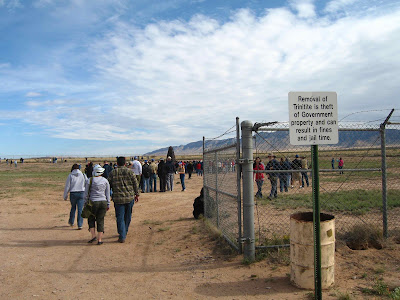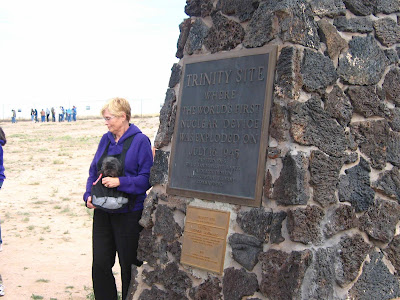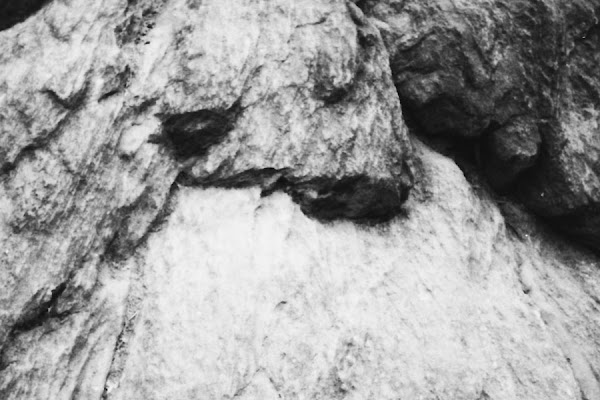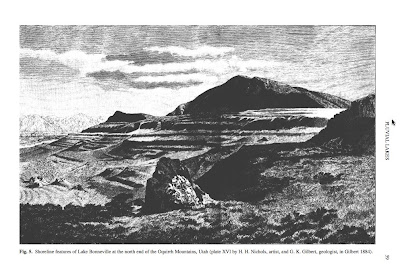Monday, December 28, 2009
Thursday, December 17, 2009
Friday, November 20, 2009
Subject: [SALT] History of innovation (Van der Leeuw talk)
Reply-To: services@longnow.org
The development of human mental ability can be tracked through the
progressive crafting of stone tools, Van der Leeuw explained. First
we learned to shape an edge---a line---then the surface, then the
whole volume of the tool, then the sophisticated sequence required to
make a superb spear point. It took 2 million years. But by 300,000
years ago the human brain had developed a sufficiently complex
short-term working memory to keep 7 (plus-or-minus 2) considerations
in mind at once. We could handle problems of multi-dimensionality.
The brain has not progressed since then, nor has needed to. The
skills of innovation moved on from the biological brain to social
constructs and modes of communication and information processing.
That bootstrapping process continues to this day. The cave paintings
show that cognitive agility reached the point of being able to reduce
3 dimensions to a representative 2 dimensions, for instance.
By the neolithic revolution of 10,000 years ago, we developed the
ability to shape voids---the interior of pots, baskets, and houses.
Tools could be made by assembling parts instead of just paring down
blanks of stone or wood. Problem solving in agriculture began to
span time, to be a form of investment.
Towns and then cities became humanity's innovation engine. Symbols
recorded in material form---tokens, accounting, and writing---spanned
time and space. Unruly cities disciplined themselves with laws and
administration. Then empires developed the ability to harvest the
bounty of far-flung communities in the form of treasure, and that led
to overreach. The Roman Empire was the first to degrade its world at
the local climate level, and it collapsed.
Around 1800, in Europe, energy constraints were finally conquered by
the harvesting of fossil fuels. Humans only need 100 watts to
survive, but every human now commands 10,000 watts. With that
leverage we built a global civilization. The innovative power of
urbanity has multiplied yet further with the coming of the internet.
But we have become "disturbance dependent." As our cities and
density of communications grow, they create ever more difficult
problems, for which we have to innovate ever more sophisticated
solutions. Technology is "the biggest Ponzi scheme of all."
As we become ever more adept at solving short-term problems, we shift
the risk to long-term problems---such as climate change---which do
not match the skills we have developed and know how to reward. We
are headed into a trap of our own devising. To get out of it, if we
can, will require a "battle with ourselves" to wholly redefine our
social structures and institutions to master the long term.
--Stewart Brand
--
Stewart Brand -- sb@gbn.org
The Long Now Foundation - http://www.longnow.org
Seminars & downloads: http://www.longnow.org/
Thursday, November 19, 2009
"This growing isolation and self-containment, exhibited by the other members of the unit and from which only the buoyant Riggs seemed immune, reminded Kerans of the slackening metabolism and biological withdrawal of all animal forms about to undergo a major metamorphosis. Sometimes he wondered what zone of transit he himself was entering, sure that his own withdrawal was symptomatic not of a dormant schizophrenia, but of a careful preparation for a radically new envirnoment, with its own internal landscape and logic, where old categories of thought would merely be an encumbrance."



Sunday, October 4, 2009
perspective from above
Saturday, October 3, 2009
in search of authentic experience
click to enlarge images:
 amidst the extinct volcanoes and lake, deep in the Jornada Del Muerto:
amidst the extinct volcanoes and lake, deep in the Jornada Del Muerto:

 the biggest surprise was the turn out
the biggest surprise was the turn out
 food to the left
food to the left
 radioactive materials to the right
radioactive materials to the right
 apparently nuclear tourism is extremely popular with people of all ages
apparently nuclear tourism is extremely popular with people of all ages
 people came by the bus load
people came by the bus load



 hundreds of people gathered
hundreds of people gathered
 shared stories
shared stories
 scoured the desert floor for Trinitite
scoured the desert floor for Trinitite
 found it
found it
 stood back and took it all in
stood back and took it all in
 a replica of Fat Man was trucked in
a replica of Fat Man was trucked in
 almost everyone posed by the obelisk for a photo
almost everyone posed by the obelisk for a photo
 some people got creative
some people got creative
 others brought their dogs
others brought their dogs

 meanwhile, outside the White Sand Missile Testing Range, the landscape maintains
meanwhile, outside the White Sand Missile Testing Range, the landscape maintains
 clarity and breathtaking expanse
clarity and breathtaking expanse

 many pueblos are scattered throughout the area.
many pueblos are scattered throughout the area.
 amidst the extinct volcanoes and lake, deep in the Jornada Del Muerto:
amidst the extinct volcanoes and lake, deep in the Jornada Del Muerto:
 the biggest surprise was the turn out
the biggest surprise was the turn out food to the left
food to the left radioactive materials to the right
radioactive materials to the right apparently nuclear tourism is extremely popular with people of all ages
apparently nuclear tourism is extremely popular with people of all ages people came by the bus load
people came by the bus load


 hundreds of people gathered
hundreds of people gathered shared stories
shared stories scoured the desert floor for Trinitite
scoured the desert floor for Trinitite found it
found it stood back and took it all in
stood back and took it all in a replica of Fat Man was trucked in
a replica of Fat Man was trucked in almost everyone posed by the obelisk for a photo
almost everyone posed by the obelisk for a photo some people got creative
some people got creative others brought their dogs
others brought their dogs
 meanwhile, outside the White Sand Missile Testing Range, the landscape maintains
meanwhile, outside the White Sand Missile Testing Range, the landscape maintains clarity and breathtaking expanse
clarity and breathtaking expanse
 many pueblos are scattered throughout the area.
many pueblos are scattered throughout the area.
Thursday, September 24, 2009
60 hours in NM
At the end of our trip in July I couldn't have imagined being back so soon. But, we're picking up the thread again and making a short intentional trip to New Mexico next weekend. The centerpiece of the voyage will be the annual open house for Trinity, the site of the world's first nuclear detonation. This is where on July 16, 1945 at 5:29 a.m. the world entered the "atomic era". A pivot point in global history. What was unleashed that summer morning in/upon/through this particular stretch of New Mexican desert, and in turn the world, continues to shape the reality of 2009.
A year ago, on the same weekend that we will be at Trinity this year, we were in Reno for the Art + Environment conference. We were about to tour the Nevada Test Site for the first time. It was at the A + E conference that we met Geoff Manaugh. Now, one year later, we are happily included in his Landscapes of Quarantine project in New York. Much has been learned and gathered in this past year.
Next weekend will undoubtedly be a time of reflection about where we have arrived in 365 days. It will offer a context for connecting the myriad of spaces and times that encompass this particular year's experiences and makings. It will be a continuation of a process and practice underway as well as another stepping off point into the next. If visiting Trinity is similar to the other nuclear sites that we have been to thus far the experience of being there will cause everything outside of this place to temporarily fall away. An internal upheaval will return as this place's very particular reality and totality becomes real-ly lived and felt.
A relationship with this landscape has been building over the course of the last three years. Our attendance at the "open house" will only deepen this. We will be crossing through gates typically closed, passing through once again, and slipping momentarily into a space and time inaccessible in daily life.
I'll be making another postcard for Freeman Dyson from the site and we'll be taking photos to be included in our upcoming exhibition in Red Hook. We'll also be gathering last bits of imagery for our newsprint, Worlds To Come: A Field Guide, which will be published en masse in November.
In the days between now and next Saturday I'll be thinking about ways to come to this site in the present tense, despite all that I have read and imagined about it up to this point. Though Robert J. Oppenheimer's much quoted words will be resonating in my mind, I'd like to come to this place as clear as possible. What might this place offer us in the midst work that we are intently making? How will the ceremonial "opening" this site (to the public) get taken up by us?
Regardless of outcomes, it will be magical to connect, once again, with the endlessly mysterious and ever enchanting landscapes of New Mexico.
A year ago, on the same weekend that we will be at Trinity this year, we were in Reno for the Art + Environment conference. We were about to tour the Nevada Test Site for the first time. It was at the A + E conference that we met Geoff Manaugh. Now, one year later, we are happily included in his Landscapes of Quarantine project in New York. Much has been learned and gathered in this past year.
Next weekend will undoubtedly be a time of reflection about where we have arrived in 365 days. It will offer a context for connecting the myriad of spaces and times that encompass this particular year's experiences and makings. It will be a continuation of a process and practice underway as well as another stepping off point into the next. If visiting Trinity is similar to the other nuclear sites that we have been to thus far the experience of being there will cause everything outside of this place to temporarily fall away. An internal upheaval will return as this place's very particular reality and totality becomes real-ly lived and felt.
A relationship with this landscape has been building over the course of the last three years. Our attendance at the "open house" will only deepen this. We will be crossing through gates typically closed, passing through once again, and slipping momentarily into a space and time inaccessible in daily life.
I'll be making another postcard for Freeman Dyson from the site and we'll be taking photos to be included in our upcoming exhibition in Red Hook. We'll also be gathering last bits of imagery for our newsprint, Worlds To Come: A Field Guide, which will be published en masse in November.
In the days between now and next Saturday I'll be thinking about ways to come to this site in the present tense, despite all that I have read and imagined about it up to this point. Though Robert J. Oppenheimer's much quoted words will be resonating in my mind, I'd like to come to this place as clear as possible. What might this place offer us in the midst work that we are intently making? How will the ceremonial "opening" this site (to the public) get taken up by us?
Regardless of outcomes, it will be magical to connect, once again, with the endlessly mysterious and ever enchanting landscapes of New Mexico.
Wednesday, September 23, 2009
Thursday, July 16, 2009
Thursday, July 9, 2009
Recto Vegas
The term recto-verso is used in the worlds of printing, binding, and publishing. It describes a two-sided text or the front and back of a one-sheet artwork. A recto-verso drawing is a sheet with drawings on both sides. While recto means "front side" of a leaf, and verso refers to the reverse or back, usually there is no obvious primary side.
Recto Vegas approaches the casinos of the Las Vegas strip as recto-verso visual texts. Our project questions whether the Casinos of the Las Vegas strip have a primary side.
We photographed the casinos as many visitors do: by shooting from the window of a moving car--an instinctual reaction to the reality that the strip offers more than can ever be taken in from a single vantage point.
We took the night photos during one pass up the strip, from south to north. The daytime photos were taken during two passes from north to south: early morning down the east side of the strip looking west and late afternoon down the west side of the strip looking east.
Whether it's Recto Vegas or Vegas Verso--it's prime "Las Vegas."
(click to enlarge images)

The term recto-verso is used in the worlds of printing, binding, and publishing. It describes a two-sided text or the front and back of a one-sheet artwork. A recto-verso drawing is a sheet with drawings on both sides. While recto means "front side" of a leaf, and verso refers to the reverse or back, usually there is no obvious primary side.
Recto Vegas approaches the casinos of the Las Vegas strip as recto-verso visual texts. Our project questions whether the Casinos of the Las Vegas strip have a primary side.
We photographed the casinos as many visitors do: by shooting from the window of a moving car--an instinctual reaction to the reality that the strip offers more than can ever be taken in from a single vantage point.
We took the night photos during one pass up the strip, from south to north. The daytime photos were taken during two passes from north to south: early morning down the east side of the strip looking west and late afternoon down the west side of the strip looking east.
Whether it's Recto Vegas or Vegas Verso--it's prime "Las Vegas."
(click to enlarge images)

Subscribe to:
Posts (Atom)





























